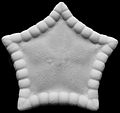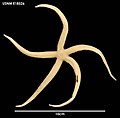There is a page named "Abactinal" on Misplaced Pages
- Abactinal article on "abactinal", but its sister project Wiktionary does: Read the Wiktionary entry "abactinal" You can also: Search for Abactinal in Misplaced Pages... 312 bytes (0 words) - 08:01, 11 May 2021
 Asterias spines on its abactinal plates, instead of large, spherical tubercles; and from Anasterias by the well-developed, reticulate, abactinal skeleton. The... 12 KB (1,071 words) - 03:30, 12 December 2024
Asterias spines on its abactinal plates, instead of large, spherical tubercles; and from Anasterias by the well-developed, reticulate, abactinal skeleton. The... 12 KB (1,071 words) - 03:30, 12 December 2024Sthenaster emmae has five arms, a triangular outline, actinal intermediate plates, abactinal plates, ranges from 42mm - 45mm wide, and is usually an orange color.... 2 KB (223 words) - 22:29, 2 December 2023
 Apollonaster They can be identified by their bare abactinal plate surfaces and multiple accessory granule rows on their abactinal plates. To date, Apollonaster has been... 2 KB (199 words) - 03:15, 2 December 2023
Apollonaster They can be identified by their bare abactinal plate surfaces and multiple accessory granule rows on their abactinal plates. To date, Apollonaster has been... 2 KB (199 words) - 03:15, 2 December 2023 Xyloplax janetae the animal, of distinct morphology. On its dorsal (abactinal surface) it has many projecting abactinal spines whose morphology is distinct from the adambulacral... 2 KB (193 words) - 15:47, 12 December 2023
Xyloplax janetae the animal, of distinct morphology. On its dorsal (abactinal surface) it has many projecting abactinal spines whose morphology is distinct from the adambulacral... 2 KB (193 words) - 15:47, 12 December 2023 Apollonaster kelleyi Apollonaster genus based on its bare abactinal plate surfaces and multiple accessory granule rows on its abactinal plates. The species name kelleyi was... 1 KB (124 words) - 03:25, 2 December 2023
Apollonaster kelleyi Apollonaster genus based on its bare abactinal plate surfaces and multiple accessory granule rows on its abactinal plates. The species name kelleyi was... 1 KB (124 words) - 03:25, 2 December 2023Pedicellaria surrounding the spines, on the surface of the animal's body, in pits on the abactinal, marginal, or actinal surface, and/or within the adambulacral plate adjacent... 6 KB (512 words) - 04:19, 7 December 2024
Echinaster Echinaster brasiliensis: A-Spines of arm, B-Tube feet, C-Abactinal view of Arm.... 22 KB (2,501 words) - 18:26, 30 October 2024
 Brissus agassizii (Allobrissus) agassizii. A: denuded test, abactinal view; B: test, actinal view; C: specimen with radioles, abactinal view; D: denuded test, side view; E:... 1 KB (54 words) - 18:40, 17 September 2022
Brissus agassizii (Allobrissus) agassizii. A: denuded test, abactinal view; B: test, actinal view; C: specimen with radioles, abactinal view; D: denuded test, side view; E:... 1 KB (54 words) - 18:40, 17 September 2022Heliaster microbrachius with more or less flattened rays. Abactinal spines are very numerous, small, more or less cylindrical. Color of abactinal surface may be purplish or grayish-black... 3 KB (303 words) - 02:28, 30 September 2024
 Marginix Ruedemann studied a single specimen of this species, exhibiting the abactinal side of the animal, cataloged as NYSM 7762 and designated as the holotype... 7 KB (699 words) - 15:53, 27 August 2024
Marginix Ruedemann studied a single specimen of this species, exhibiting the abactinal side of the animal, cataloged as NYSM 7762 and designated as the holotype... 7 KB (699 words) - 15:53, 27 August 2024 Rathbunaster on abactinal surface of rays are more numerous than in Pycnopodia and each bears a wreathed spine, whereas in Pycnopodia spines are rare on abactinal plates... 9 KB (1,104 words) - 01:51, 2 December 2023
Rathbunaster on abactinal surface of rays are more numerous than in Pycnopodia and each bears a wreathed spine, whereas in Pycnopodia spines are rare on abactinal plates... 9 KB (1,104 words) - 01:51, 2 December 2023 Zoroaster fulgens arms is made up of different overlapping ossicles called the carinals, abactinals, marginals (only one row), actinals (several rows), adambulacral, and... 16 KB (1,923 words) - 07:16, 28 November 2024
Zoroaster fulgens arms is made up of different overlapping ossicles called the carinals, abactinals, marginals (only one row), actinals (several rows), adambulacral, and... 16 KB (1,923 words) - 07:16, 28 November 2024 Brisingida the lack of actinal plates, a spool-like ambulacral column, reduced abactinal plates, and crossed pedicellariae. They are 40 times the size of disk... 6 KB (649 words) - 05:09, 12 September 2024
Brisingida the lack of actinal plates, a spool-like ambulacral column, reduced abactinal plates, and crossed pedicellariae. They are 40 times the size of disk... 6 KB (649 words) - 05:09, 12 September 2024 Aquilonastra chantalae could have up to 7 rays. Specimens of this kind have mostly digitiform abactinal spinelets. They also have actinal interradial spines which are predominantly... 4 KB (518 words) - 21:32, 28 December 2023
Aquilonastra chantalae could have up to 7 rays. Specimens of this kind have mostly digitiform abactinal spinelets. They also have actinal interradial spines which are predominantly... 4 KB (518 words) - 21:32, 28 December 2023
- Word definitions from Wiktionaryabactinal nl̩/, /ˌæˌbækˈtaɪ.nl̩/, /ˈæˌbækˌtaɪ.nl̩/ abactinal (comparative more abactinal, superlative most abactinal) (zoology) Pertaining to the surface or endSee all results
- Texts from Wikisource1911 Encyclopædia Britannica/Echinoderma exothecally upon jointed outgrowths of the abactinal thecal plates (brachia), carrying with them extensions of the abactinal nerve-system. The number of theseSee all results